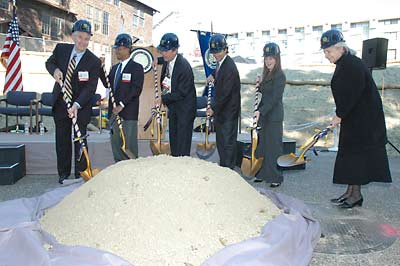UC Berkeley Web Feature
 Ground is symbolically broken for the new CITRIS Headquarters Building, located between Davis and Cory Halls. Digging in were (from left) Chancellor Robert Birgeneau; donor Dado Banatao; UC President Robert Dynes; David Crane, special adviser to Gov. Schwarzenegger for jobs and economic growth; graduate student Elizabeth Reilly; and outgoing CITRIS director Ruzena Bacjsy. CITRIS - the Center for Information Technology Research in the Interest of Society - aims at developing new technologies to solve complex problems facing society. (Peg Skorpinski photo) |
Construction launched for CITRIS building to foster innovative technological research and education
BERKELEY – With ceremonial tosses of dirt, UC Berkeley on Friday kicked off construction of the new headquarters building for the Center for Information Technology Research in the Interest of Society (CITRIS), the campus's newest classroom and research facility.
In the new building - to be located in the northeast corner of the campus, adjacent to Cory and Davis Halls - students and faculty will make technological breakthroughs needed to solve some of society's most pressing challenges, in areas ranging from energy to national security and from health care to the environment.
"Today we are breaking ground, literally, for tomorrow's groundbreaking discoveries," said UC President Robert Dynes, one of a host of dignitaries on hand for the celebration.
 Artist's sketch of the new CITRIS headquarters building. (Courtesy Facilities Services) |
CITRIS is one of four California Institutes for Science and Innovation (Cal-ISI) established in 2000 by the state as an investment in California's future economic growth. The institutes bring together the state, academia, and industry in a partnership that helps bring innovation to the marketplace.
"These four institutes, in my view, are the first templates of what a 21st-century university is going to look like," said Dynes. "They are helping us break free from old assumptions of how research is organized, and to bring science and teaching to bear on society."
Chancellor Robert Birgeneau, who also spoke at the event, said, "It is clear how exciting CITRIS is and how it builds on the exceptional strengths of UC Berkeley." Because of Berkeley's breadth and academic strength, he said, there is a "willingness to take on challenges that other universities wouldn't," such as a research effort of CITRIS's magnitude.
David Crane, representing the governor, emphasized the role academic research plays in spurring new industry for the state. "Just as mining was the mainstay a century ago, engineering and technology drive California's economy today," he said. "And state-of-the-art facilities like this one are critical to maintaining the preeminence of California."
In a written statement, Gov. Schwarzenegger called the Cal-ISIs "job creators that fuel the California economy." A note was also read from former Gov. Gray Davis, who spearheaded the Cal-ISI program and said "the mission of the institutes was to invent the future."
Mechanical engineering graduate student Elizabeth Reilly, one of the many students working with CITRIS, told the more than 300 guests at the groundbreaking why the institute is important to her: "I came to Cal because I felt there was an opportunity to do research that really matters," she said. "A center like CITRIS that is truly in the interest of society - that's where my research interests lie."
The event began with a talk by Richard Newton, dean of the College of Engineering, outlining CITRIS progress and the nature of the work done at the institute. Interaction among CITRIS faculty and students with experts in a variety of fields drives technical developments, Newton said - whether it is working with a team of Berkeley faculty and students who traveled to Japan to study liquefaction in the wake of recent earthquakes, giving biologists a wealth of data on microclimates from sensors atop redwood trees, or collaborating to increase energy efficiency in buildings.
Newton also explained that anyone who wants to make use of CITRIS-developed technologies can obtain a royalty-free license, a practice meant to spur new ideas and companies. He noted, for example, the half-dozen companies that have spun off of the CITRIS work of Kris Pister, professor of electrical engineering and computer sciences. Pister developed "smart dust," tiny, low-cost, wireless sensors that form networks and make possible a wide range of innovations. Newton said projections are that by 2008 the smart dust industry will be valued at between $1 billion to $2.5 billion - a boon to the economy that "started five years ago with an idea from a faculty member."
The 145,000-square-foot CITRIS Headquarters Building with five above-ground and two basement floors will replace the old Davis Hall North. The facility will house a center for distance learning, a nanofabrication laboratory, and flexible educational and research facilities; the facility will link to the other UC campuses that are partners in CITRIS: Davis, Merced, and Santa Cruz.
Within the building's walls, faculty and student researchers will work on projects such as an electronic ImmunoSensor chip that can detect the presence of dengue virus and other pathogens in human blood, sensors that can help structural engineers assess the safety of a building or help firefighters navigate their way out of smoke-filled buildings, and a cybersecurity testbed that helps computer experts develop defenses against network attacks.
Construction of the building is expected to be complete in 2007. For more information about CITRIS, visit www.citris-uc.org.

